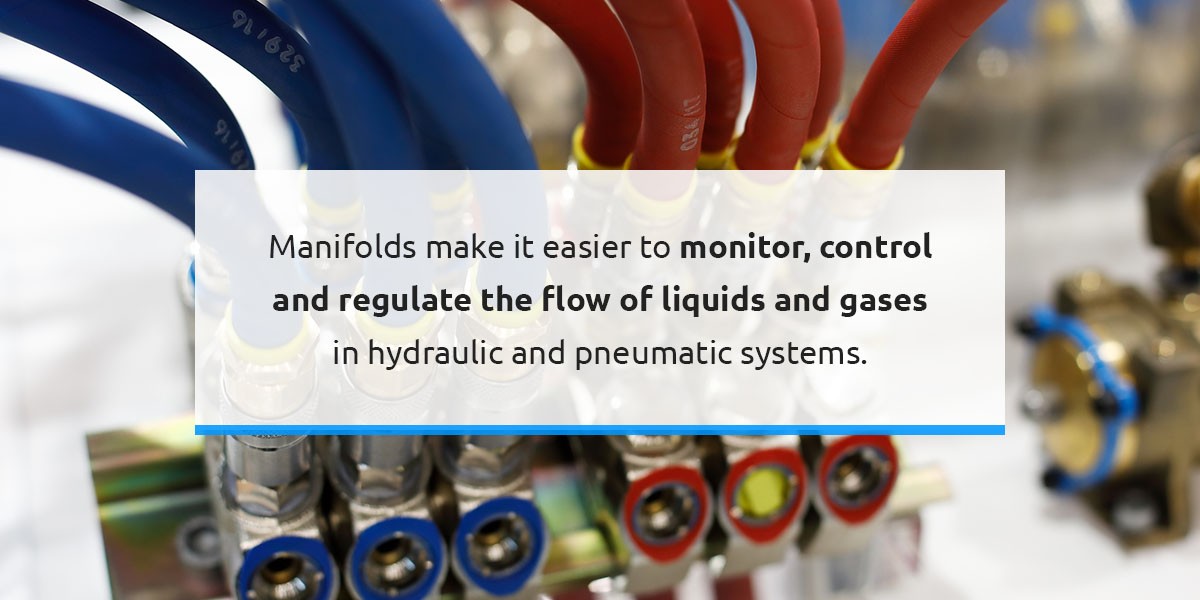What Is a Manifold?

Pressurized fluid pipelines need manifolds to improve the flow and distribution of gas or oil. Manifolds are easy-to-use systems that consolidate several manifold valves into a single assembly to streamline fluid flow.
They’re useful for pipelines that require multiple valves and systems that perform multiple functions simultaneously. Incorporating manifolds into hydraulic or pneumatic systems has numerous benefits, including enabling efficient system performance. This article discusses the key details about manifolds to help companies understand why they’re important.
Understanding Manifolds
A manifold is a hollow structure containing arrangements of process valves, tubes, pipes, fittings and pressure equipment. It consists of a block or a central body with numerous inlet and outlet ports and a series of interconnected valves. Manifold systems combine numerous valves into a single channel that splits one supply input into several outputs.
It contains several key components that complete various functions, including:
- A hollow tube or pipe that facilitates the unobstructed fluid flow through several ports.
- Pipe fittings, such as plugs, crosses, elbows and tees, which join the pipe or tube to the manifold.
- One or more manifold valves used to control the fluid flow in pneumatic or hydraulic systems.
- Pressure gauges and switches attached to the manifold to track measurements and metrics.
Numerous materials can be used to make manifolds. These are chosen based on fluid compatibility, performance, corrosion and wear resistance. The most common materials include aluminum, plastic, ductile iron, steel and stainless steel. Manifolds made using these materials react differently to different chemicals and fluids, so your company needs to consider the choice carefully.
Applications of Manifolds in Various Industries
Manifold valves are found in various pneumatic and hydraulic systems. They’re generally useful for industrial applications with multiple fluid lines that must be monitored, controlled and regulated simultaneously. All uses of manifolds require force created by the movement of fluids. So, where and how are manifolds used? The following are some of the most popular applications of manifolds:
- Regulating fluid flow in power-heavy hydraulic and pneumatic machinery.
- Controlling fluid flow when filling bottles in the food and beverage industry.
- Regulating flow in medical equipment such as blood analyzers, laboratory equipment, dialysis equipment and clinical diagnostics.
- Guiding oil and gas into gauge or surge tanks for storage or measurements.
- Facilitating hydraulic fracturing, extraction systems and oil exploration in the oil and gas industry.
- Directing the flow of crude oil from the separator into the burner for disposal.
Types of Manifolds in Industrial Settings
The two main types of manifolds used in industrial settings are single-piece and modular block manifolds. The choice depends on the system type, size and purpose.
Single-Piece Design Manifolds
A single-piece design manifold consists of a single device that supports all the necessary valving and passages for the entire system. This device harbors all the passages within the systems and includes a drilled block that creates holes for various ports and flow paths. Single-piece design manifolds are often made of aluminum, plastic or steel, which are materials that support pressure applications.
Single-piece manifolds are further categorized into laminar-type and drilled block manifolds. Laminar-type manifolds comprise multiple layers of metal or plastic with machined passages to facilitate the flow of different fluid passages. Drilled block manifolds comprise a metal or plastic block drilled to create flow passages that meet custom design preferences.
Modular Block Design Manifolds
Modular manifold systems are a more adaptable alternative to single-piece manifolds that combine single blocks. You can easily modify the modular block designs by adding or removing blocks.
They require end plates connecting to pumps and tanks and sealing the assembled manifold. This manifold design contains interconnecting plates placed between blocks to redirect flow between passages. Divider plates prevent flow between blocks, and spacer plates increase the dimensions between plates by adjusting the space between blocks.
Benefits of Manifolds
While the main goal of manifolds is to combine multiple valves into a single assembly and streamline fluid flow, these devices provide many benefits to companies in many industries. Here are the top benefits of manifolds:

- Make it easier to monitor, control and regulate the flow of liquids and gases in hydraulic and pneumatic systems.
- Improve performance and efficiency by minimizing the number of connections.
- Boost convenience with multiple output lines and compact cartridge sizes.
- Provide cost savings as a result of reduced costs of assembly and installation.
- Create space savings resulting from lower space requirements and compact cartridge sizes.
- Minimize the number of threaded or flanged connections, resulting in fewer leaks.
- Minimize energy costs by reducing the weight of the system.
- Create a shorter and faster path, reducing the risk of pressure drop and heat fluctuations.
- Decrease the need for maintenance against corrosion, stress, fatigue, wear and loose joints.
Frequently Asked Questions
The following are additional commonly asked questions about manifolds.
What Do Manifolds Do?
Manifolds diverge or converge fluid at different junctions in a fluid processing or distribution system. They control and manage efficient fluid flow within a hydraulic or pneumatic system. Manifolds simplify fluid distribution and help regulate its pressure, timing and direction.
What Is a Manifold Valve?
A manifold valve is a device that consists of a ball, bleeds and needles. They block a connection to a process or equalize pressure between two ports. There are different types of manifold valves, with the following being the most common types:
- 2-way manifold valves: These consist of at least two valve configurations that simplify isolating, calibrating or blocking systems and transmitters.
- 3-way manifold valves: These consist of an equalizing valve and two process isolation valves, which connect system impulse lines and transmitters.
- 5-way manifold valves: These consist of two vent valves, two isolation valves and one equalization valve, and they are used in differential pressure transmitter applications.
What Is a Manifold Pressure Gauge?
A manifold pressure gauge measures the liquid or gas pressure within the intake manifold between the throttle body and cylinders.
What Is a Manifold Gasket?
A manifold gasket acts as a seal to prevent fluids from escaping the system. It maintains consistent and reliable fluid flow, ensuring the system has enough fluid.
Request a Manifold Quote From Global Electronic Services
Installing manifolds in your hydraulic or pneumatic systems has various benefits, including improving performance, increasing space savings and reducing costs. Global Electronic Services offers repairs and servicing for industrial electronic, hydraulic and pneumatic systems. Request a quote today to schedule an on-site assessment of your system to determine the best manifolds for your company’s systems.

